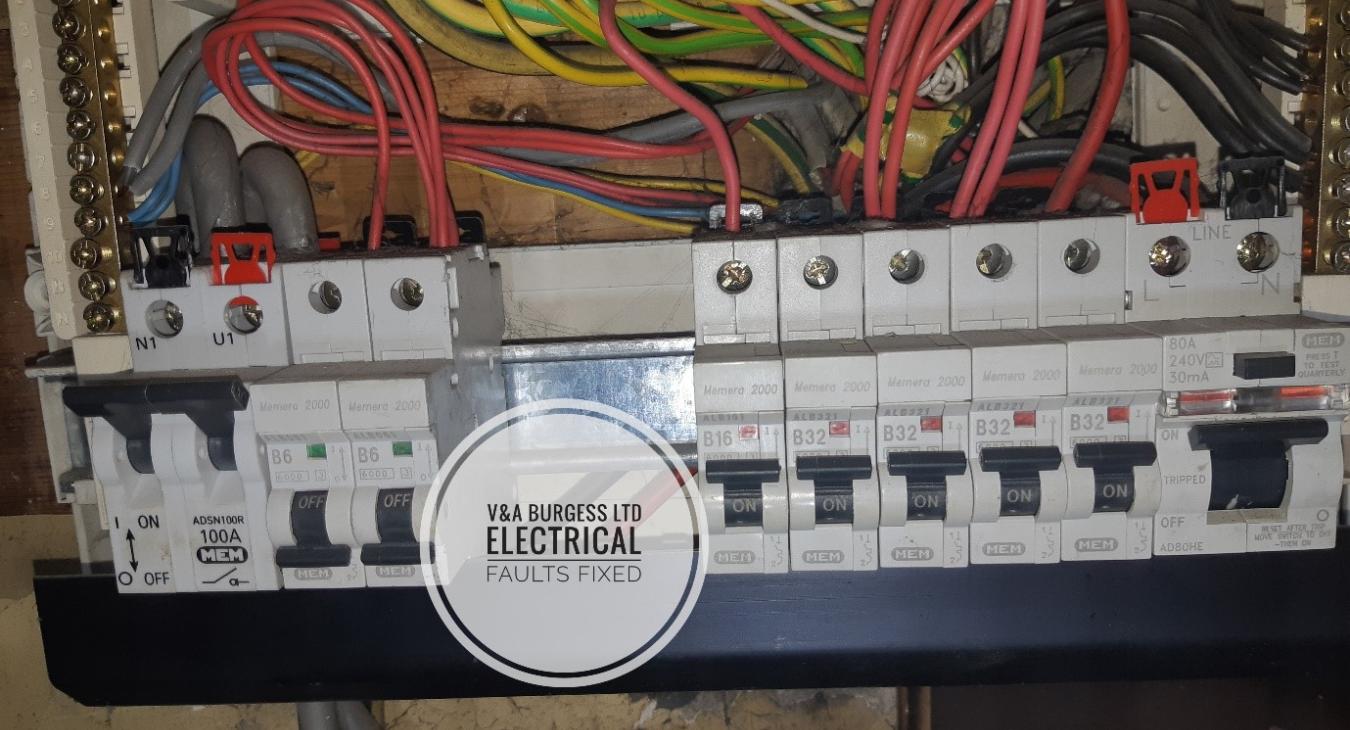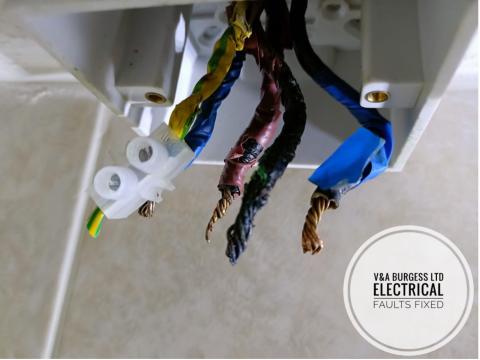
Table of Contents
- HOW MUCH IS A NEW CONSUMER UNIT?
- Size of the Property
- Number of Electrical Circuits
- Hidden Faults or Problems
- Any upgrades to the Wiring System
- Is every quote the same?
- What else do I need to think about?
- Modern Safety Features
- Electric Shock Protection
- Surge Protection
- Arc Fault Detection
- Summary
- Common Questions
The consumer unit above is approximately 30 years old at the time of writing. It is not inherently dangerous, does not pose an immediate risk to anyone and realistically will provide several more years of maintenance free service in all likelihood.
Back to top1) HOW MUCH IS A NEW CONSUMER UNIT?
A new consumer unit typically costs from £450 - £900. The average cost is around £700.
The costs will depend upon various factors:
- Size of the property
- Number of Electrical Circuits
- Hidden Faults or Problems
- Any upgrades to the wiring system
If you want to know more about consumer units or have questions about them then check the BIGGEST question and answer article written here.
Back to top2) Size of the Property
The larger the property the more work is required in order to fully carry out the consumer unit change. It is not simply a case of screwing a new unit to the wall and connecting up the wires, everything has to be tested so the electrician can confirm that the electrical system is safe to energise and the work can be certificated and signed off correctly.
The larger the property, the more rooms there are, the more sockets and switches there are that need to be checked and tested and therefore the more the labour costs will be. A new consumer unit will cost more in a larger detached home compared to a studio flat.
Back to top3) Number of Electrical Circuits
Our home wiring system is divided up into electrical circuits. We have a separate circuit for the lights, the plug sockets, the electric cooker, and the electric shower. In larger properties there are often several plug socket circuits, lighting circuits and other electrical circuits.
The more electrical circuits there are in a property, the longer it will take to test, inspect, and certify that these are safe. This takes longer and becomes more expensive.
Without dividing the electrical system up into smaller circuits, it would be very inconvenient when there was an electrical fault as the whole house would lose power simultaneously. Older fuse boxes are set up in this manner and this is no longer compliant with the wiring regulations.
Back to top4) Hidden Faults or Problems
When old technology is replaced with new technology, the new stuff is better at picking up problems than the old stuff is. Its that simple. Read our article on a NEW CONSUMER UNIT with OLD WIRING
The old fuse box contained a piece of thin wire for each circuit that would heat up and blow when there was a large electrical fault current. The newer boxes will do this too but they will also provide electric shock protection, surge protection and in some cases, protection against electrical arcing and fires.
Due to the sensitivity of the modern consumer unit, any pre-existing issues that went undetected by older technology are likely to trip the new unit and result in issues turning on, reconnecting electrical circuits or pose safety issues.
If wiring is not safe to reconnect then the electrician will need to leave any dangerous or non-compliant circuits disconnected and will not be able to certificate the work until the problems are rectified. This usually costs more time and money to put right. The question of HOW MUCH IS A NEW CONSUMER UNIT if often not straightforward to answer.
Back to top5) Any upgrades to the Wiring System
Where the wiring system is particularly old, there may be some parts of the electrics that need to be upgraded in order for the new consumer unit to function as it should.
Issues with earthing, undersized cables, damaged electrical accessories, or other electrical problems need to be fixed before the new consumer unit can be properly signed off by your electrician.
In some older properties, there was occasionally no earth wire for certain circuits meaning that metal light fittings or light switches should NOT have been installed. In these circumstances any metal lights or switches may need to be replaced for plastic OR the affected part of the wiring installation rewired in order to make things safe.
Back to top6) Is every quote the same?
When purchasing a new car there are many different trim levels and you need to check what is included after all, not getting air conditioning can be a real deal breaker these days.
When having a board change/consumer unit change carried out, it’s a good idea to check with your contractor that their overall cost and quote includes:
- Dismantling and removing the old fuse box?
- The issuance of an Electrical Installation Certificate?
- The Building Control Notification and Certificate?
- RCBO boards, High Integrity Consumer Unit, Dual RCD consumer unit (old tech now) OR split Load Consumer Unit (obsolete now)?
- New Meter Tails
- Bonding of Gas pipes or Water pipes
- Any additional costs
Don’t forget to check their online reviews for previous work that they may have carried out for other customers.
Back to top7) What else do I need to think about?
There are key elements to consider when changing a consumer unit or having an upgraded unit fitted by your electrician.
- Modern Safety Features
- Electric Shock Protection
- Surge Protection Devices
- Overload Protection
- Arc Fault Detection
- Testing the existing wiring
8) Modern Safety Features
The modern safety features that we install now are compliant with regulations and will ensure the safety of you and your family inside your home. We discuss more about these below, but a modern consumer unit is the best way of updating and upgrading your electrical system to ensure that you and your family benefit from the latest safety developments.
Imagine driving a vehicle from the 1980s without air bags or anti-lock brakes? Its much better to drive around in a modern car with all the latest safety features and your electrical system can also benefit from new technology.
Back to top9) Electric Shock Protection
An electrician should now ensure that all of your homes wiring has the correct type of electric shock protection when an electrician installs a new consumer unit for you.
These electric shock prevention devices (RCD – residual current device) are tested by your electrician to ensure that in the event of a fault, someone receiving a serious shock or some issue on the circuit, the device will cut the power supply to the circuit and prevent any serious injuries.
Without the right RCD protection, tested correctly and certified as safe and working, your home and its occupants will not be protected properly against electric shocks.
Back to top10) Surge Protection
An electrician should ensure that your home has built in surge protection in the consumer unit. This prevents excessive levels of voltage from entering your cabling or appliances in the home and causing damage or accelerated failure of delicate components like the television, fridge, and other circuitry sensitive to voltage fluctuations.
It is common for minor voltage spikes to occur; these are not dramatic high voltages that make appliances blow up like in the movies but rather they are small continuous higher voltages that appliances do not like and are not designed to cope with.
A surge protection device sends any excessive voltage to earth and protects everything in your home but they will occasionally need replacing. Your electrician will be able to advise you more on the details of these.
11) Arc Fault Detection
We always recommend having Arc Fault Detection Devices installed where necessary. At the time of writing (2024), these devices are a little pricey but the technology is decreasing in cost on a monthly basis. These devices help prevent fires in the homes electrical system and damage to cables by detecting where there is arcing occurring and cutting the power supply to the affected circuit.
These devices are not currently effective for EVERY electrical circuit in your home so it’s best to check with your electrician as to which devices are going to work best in your home and let them guide you.
Back to top12) Summary
When you want to know HOW MUCH IS A NEW CONSUMER UNIT, remember that as nearly every electrical installation is different there can be varying costs involved in the final work that is carried out. You should always budget for potential remedial works that may be necessary when having a new consumer unit installed.
Any decent qualified electrician will be happy to chat to you about the potential costs, pitfalls and problems that may occur and the likely costs of these.
One way to avoid any issues is to have a full electrical inspection carried out BEFORE the new unit is installed.
The electrician will give you an EICR (Electrical Installation Condition Report) and explain the issues found and the likely costs associated with repairs. You can then keep your old unit, get other quotes for the required work to bring the installation up to current electrical regulations and consider your options.
If you need advice about the type of consumer unit you might need, current regulations regarding electrical wiring or the building regulations relating to electrical to a new electrical consumer unit then do not hesitate to get in touch. We are always happy to help. Check below for common questions and answers.
Back to top13) Common Questions
13.1) What are the typical costs for a small consumer unit?
A small garage consumer unit could cost around £350 to supply, install, test, and certify. A very large consumer unit for a 5-bedroom detached home with many electrical circuits could cost around £950 to supply, install, test, and certify. (2024) This does assume that there are no electrical problems that require fixing before completing the installation of the consumer unit. As the number of circuits increases, so does the cost of installation, testing and certification.
13.2) How much do electrical problems cost to fix?
Typical electrical problems like a broken ring final circuit could cost as little as £80 to fix if the issue is hidden behind a plug socket. A broken earth on the lighting circuit could cost up to £150 to fix if many light fittings and switches have to be removed in order to find the problem.
Burnt out wiring could cost £100-£500 to put right. There are a lot of different factors to consider when working out the costs involved. One of the main issues when considering how much electrical problems might cost to fix is ACCESS.
A small problem that is very accessible is going to be less money to put right than a larger problem that is buried in a wall, floorboards, or loft space.
Electrical faults have no fixed repair price and it really does depend on the nature of the issue as to the cost.
13.3) What is a broken ring circuit?
Many UK homes have plug socket circuits that have been installed in a ring formation. Think of a cable leaving the consumer unit / fuse box and running to the first plug socket then daisy chaining around all the plug sockets and finally returning to the consumer unit again such as to create a ‘RING’.
A ring is perfectly safe and happy so long as it isn’t ‘broken’. A broken ring can occur through loose connections, burnt out wiring or incorrectly carried out electrical work. In any event, the minute a ring is broken it can be very dangerous. If may no longer trip the miniature circuit breaker or blow the fuse wire in the consumer unit if there is an overload.
The biggest danger is that there is absolutely no sign of a broken ring until an electrician carries out some checks on the circuit.
13.4) Why do electricians test?
Testing electrical installations is a vital part of the work required when changing a consumer unit. It is not enough to turn up and screw a new box to the wall then leave. How does anybody know if the homes’ wiring is safe without testing? Will the new box protect against electric shock correctly? Is the earthing at the property safe and the right size? Are there any breaks on circuits? All of these things are answered by testing and producing a report then discussing any issues with the customer prior to installation.
13.5) What is a Main Switch?
Generally, the main isolator for the whole electrical installation. We talk about this more in our article on the Main Linked Switch
13.6) What are Miniature Circuit Breakers?
The Miniature Circuit Breaker (MCB) is an individual switch found in a consumer unit that turns of the Line conductor of the electrical supply to an electrical circuit. The Plug sockets should have an MCB as should the Lights in the property. Each electrical circuit should have its own switch for isolating the power supply.
Beware, that even though a switch is turned off, there still could be a voltage present on the circuit so checks should be carried out before any work is attempted. An electrician with many years of experience is the best person to carry out any electrical work.
For more information on the different switches and parts in the consumer unit, check our article written just for you.
If you have any further questions about the replacement cost of a consumer unit, please don't hesitate to get in touch.
Back to top











